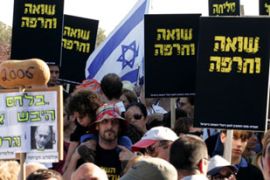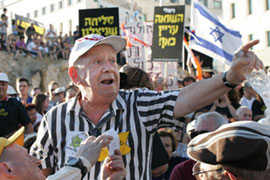Israelis protest over state aid
Holocaust survivors demonstrate against government plans to pay them $20 a month.

Published On 5 Aug 2007
Last week, the government announced plans to pay grants worth $29m to about 120,000 “survivors” over 70 living in Israel, starting in 2008.
But the announcement drew criticism, with one survivors organisation calling it an “insulting gesture”.
The plan has also been criticised as the payments would be increased year on year, while the number of survivors would be likely to dwindle as time went on.
But in the build up to Sunday’s protest, much of the focus was on what the protesters would be wearing.
Powerful symbols
 |
| Many were concerned about what the protesters would wear [AFP] |
Reports had suggested that the protesters would wear “prisoners’ clothes and yellow patches”, a reference to the death camp uniforms.
Speaking on Israel Radio, Isaac Herzog, the Israeli welfare minister, said such a gesture “in the name of a financial dispute with the government, is an insult to the collective memory of the Holocaust”.
Survivors and government officials alike argued that those symbols should not be used for political purposes and few of the protesters wore them on Sunday.
The demonstrators were made up mostly of young people, many of them descendents of survivors, with only a handful of first generation survivors marching.
Ehud Olmert, the Israeli prime minister, criticised the march as politically motivated.
Olmert was quoted in Haaretz as saying in a cabinet meeting: “Those that send to the newspapers a picture of a woman in pyjamas wearing a yellow patch, drag the discussion down to an unacceptable level, and these pictures will not dictate the government’s action on the issue.”
Meanwhile, Shimon Perez, the Israeli president, said he was confident that the government could resolve the situation.
The government has also been criticised for extending the payment to 120,000 people by expanding the definition of a survivor to those who had fled lands occupied by the Nazis.
By some estimates there are between 60,000 and 80,000 survivors living below the poverty line.
Source: News Agencies